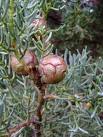Cupressus Macrocarpa Tree Information
Images of Cupressus Macrocarpa:






Cupressus Macrocarpa grows in the following 2 states and provinces:
California, HawaiiInformation about Cupressus Macrocarpa:
as well ashe Cupressus Macrocarpa is commonly known as the Monterey Cypress.
The currently accepted scientific name of Monterey cypress is Cupressus macrocarpa Gordon . It is a member of the Cupressaceae family. There are no recognized infrataxa. In New Zealand, interspecific hybrids and backcrosses between Monterey cypress and Mexican cypress (Cupressus lusitanica), and Monterey cypress and Arizona cypress (C. arizonica), occur in cultivation. These species have also been crossed artificially . Monterey cypress occurs in two natural stands in Monterey County, California. One stand is between Point Cypress and Pescadero Point on the north side of Carmel Bay, Monterey Peninsula. A smaller one is near Point Lobos on the south side of Carmel Bay . Monterey cypress is widely planted and naturalized on the California coast . It has been planted in Hawaii, Europe, South America, Australia, and New Zealand .Monterey cypress is the dominant component of the Monterey cypress forest community . This community is a moderately dense, fire-maintained forest up to 82 feet (25 m) tall in sheltered areas . Monterey cypress typically grows in pure stands with an understory of scattered dwarf shrubs and perennial herbs . It intergrades with northern coastal bluff scrub on exposed seaward edges and with Monterey pine (Pinus radiata) forest away from the ocean . Monterey cypress is associated with closed-cone coniferous woodlands and closed-cone pine-cypress forests . Publications naming Monterey cypress as a community dominant are listed below. Preliminary descriptions of the terrestrial natural communities of California The vascular plant communities of California The closed-cone pines and cypress Species not previously mentioned but commonly associated with Monterey cypress include Gowen cypress (Cupressus goveniana ssp. goveniana), California sagebrush (Artemisia californica), chamise (Adenostoma fasciculatum), Hooker manzanita (Arctostaphylos hookeri), woolyleaf manzanita (A. tomentosa), chaparral broom (Baccharis pilularis), coyotebrush (B. pilularis var. consanguinea), blue blossom (Ceanothus thyrsiflorus), liveforever (Dudleya farinosa), seaside daisy (Erigeron glaucus), golden-yarrow (Eriophyllum confertiflorum), lizard tail (E. staechidifolium), salal (Gaultheria shallon), Douglas iris (Iris douglasiana), bush monkeyflower (Mimulus aurantiacus), Pacific bayberry (Myrica californica), skunkweed (Navarretia squarrosa), poison-oak (Toxicodendron diversiloba), and California huckleberry (Vaccinium ovatum) . Some of the information provided here is attributed to:Esser, Lora L. 1994. Cupressus macrocarpa. In: Fire Effects Information System, [Online]. U.S. Department of Agriculture, Forest Service, Rocky Mountain Research Station, Fire Sciences Laboratory (Producer). , available at the USDA Fire Effects Information System (FEIS) website